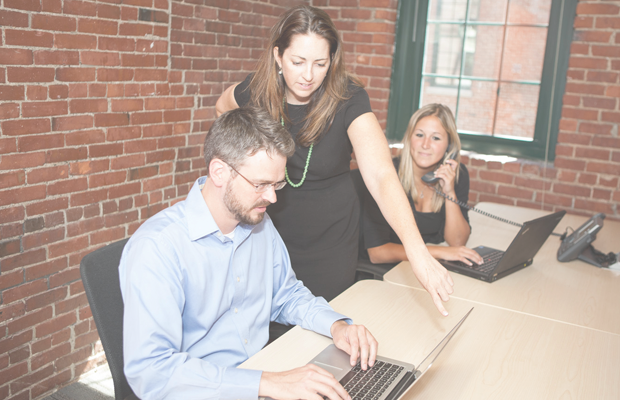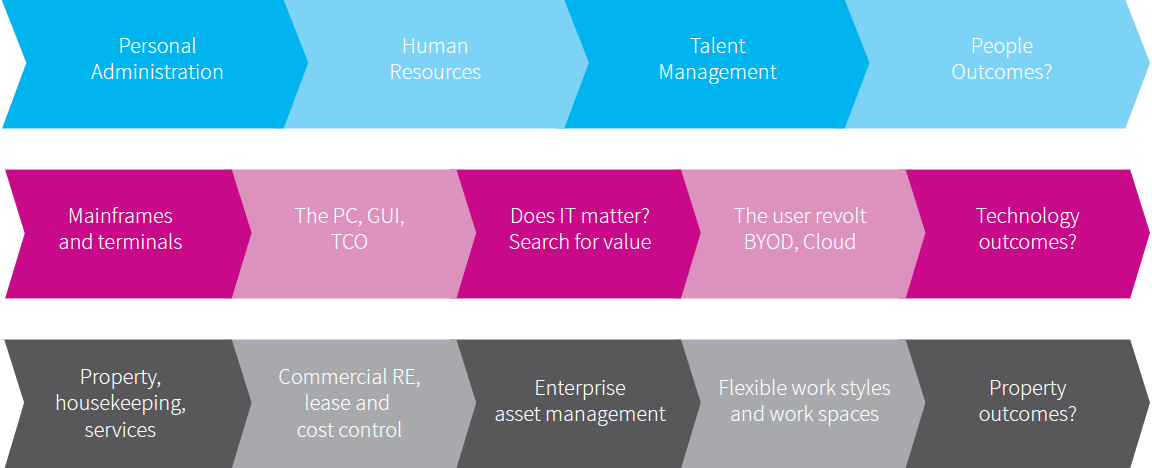As we look at the journeys that workplace (property) and people/culture (HR) have been on over the past decade, we find they have followed the same evolution as technology.
 First, a new service or capability is introduced that supports new ways of doing business. It may even bring first-mover or competitive advantage as relative advantage cannot come from capabilities everybody has but rather from things that are unusual or scarce, different or innovative.
First, a new service or capability is introduced that supports new ways of doing business. It may even bring first-mover or competitive advantage as relative advantage cannot come from capabilities everybody has but rather from things that are unusual or scarce, different or innovative.
You may also like to download this white paper: Creating Agile Organizations
Others imitate and the exponential growth slows, it becomes business as usual.
The soap box fallacy takes over – on the first day of a two day parade, a child brought a soap box and stood on it – and saw better than the other parade-goers. On the second day of the parade, everyone brings something to stand on and no one can see any better than on the first day.
So was the soap box really worth the investment? Cost control and measurement is applied and the service falters and becomes inward looking, no longer helping shape the business, but holding it back. After a while, its very relevance is questioned and the search for “business alignment” and value begins.
To increase margin, we need these support activities to be business aligned, value-driven and outcome focused.

Diagram above: The journey that people, technology, and property have been on
We are now at a nexus as people, technology, and property activities have all arrived at the same conclusion; how to show that they support the business and add value?
People, technology and workspace are now central to the organisation, and are no longer mere supporting functions but represent the potential for the core differentiation in the products and services the organisation provides.
Consider corporate IT
The origins of corporate IT lay in scheduling and inventory control, optimising and reducing errors as the amount of information grew beyond the bounds of human access and comprehension.
Decades of process automation and data-entry have been followed by networking and the personal computer. The internet now joins well over two billion computers, laptops, and tablets, probably four billion smartphones and another eight billion ‘devices’.
Organisations have come to view IT as an ever more critical resource to their success, a fact clearly reflected in their soaring spending habits.
Technology needs to be part of a more flexible model directly supporting business partners. Since we have cloud services instead of corporate infrastructure and consumer devices instead of ancient desktops, we need people focused on what and why, rather than how and when. We need technical people to have collaborative and analytical skills, who understand the outcomes and can work in business driven, cross-functional teams.
The Corporate Executive Board finds that as high as 90% of existing IT staff do not possess such skills!
What about Property?
Organisations are also questioning the role of corporate property managers and coming to the same realisation. Space adjacency analysis, a decade of flexible working, and open-plan office space design has not materially improved business outcomes. Property costs, seen only as an overhead, accelerate the pressure to reduce costs and improve space utilisation. There is little alignment with business outcomes, only claims that a new workplace will increase collaboration, attract, and retain talent.
…And HR?
The role of human resources has changed from simple administration to talent management.
All three support activities claim to produce business value while missing the central point – that technology, workspace and HR policy/culture must be coordinated for an holistic change approach.
No more ‘future workplaces’, ‘innovation labs’, enforced open-plan offices, copying ideas from competitors, culture change programmes or investing further in technology. It is time to use the data and information that is all around us and deeply understand not just the space, technology or culture but the very essence of the organisation.
Between them, IT, HR and Property have enormous information which when shared can provide deep insight, not only looking back at utilisation and cost, but forwards for strategic planning of space, technology and talent.
Such an approach enables better decisions to be made faster. Given the pace of change in every direction, we need new insight instead of ‘past experience’, ‘best guess’, or ‘perceived wisdom’. Create a dynamic operational and cultural model that supports the work and business-component needs with analytic decisions based on the biggest possible picture across all of the support services.